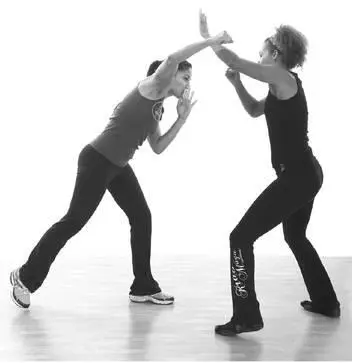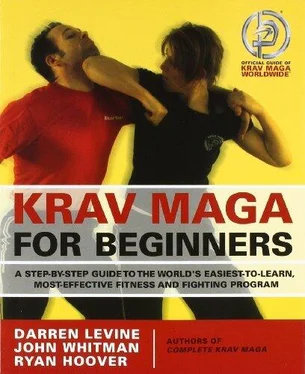We’ll take this one step farther. We encourage you not only to visualize yourself making a successful technique. We’d like you to spend one or two moments visualizing failure. Imagine the worst-case scenario. Come to accept that it might happen. Lose your fear of it. Remember, we fear what we don’t understand. Come to understand that no one is perfect, and that every one of us might fail under stress. Imagine failing in a technique. What would you do next? How would you react and recover?
Imagining failure does not mean quitting. It means preparing for reality. However, don’t spend too much time imagining failure. You don’t want to train your brain to make the wrong technique or to expect failure. The only purpose of this small aspect of training is to help remove the stress of failing. Once you’ve done a little of this worst-case scenario work, spend more of your time visualizing success: defending quickly and decisively, counterattacking powerfully, and neutralizing the assailant.
Example:
Imagine that it’s night. You walk to your front door, holding a bag of groceries in your left hand. With your right hand, you reach into your pocket or purse for your keys. You hear a motion behind you, but before you can turn, you feel an arm wrap around your throat, putting you into a headlock. You’re pulled backward, off balance. You feel intense pressure on the sides of your neck (your carotid arteries) and on your windpipe. You smell beer and cheap aftershave. You feel his shoulder and head pressed against the back of your head. You’re aware of the attacker’s hands clasped together, just over your left shoulder.
You drop the bag of groceries. Your hands fly up, over your left shoulder, bent into hooks. They pluck explosively at the attacker’s hands as you turn your left shoulder sharply into your attacker. The pluck and the turn have made a little space, and now you turn your chin. You slide your head out of the opening and continue turning. The groceries are scattered underfoot. The door is at your back and you’re now facing the attacker. You deliver a knee to the attacker’s groin. He’s wearing a dark brown shirt and denim jeans. He doubles over, but as he does he tries to grab your legs. You brace your forearms against his shoulder, keep him away, and you deliver another knee, this time to his midsection. He grunts as the air is driven from his lungs. He drops to his knees, but you can still feel him leaning forward, grabbing for you. You deliver another knee, this time to his face. You see a shaved head, an unshaven face. You feel your knee smash into his nose. He drops to the ground.
You step back and assess the situation. There are no other attackers. He’s still on his stomach, coughing and sputtering. He appears to be in his mid-twenties, Caucasian. He has big hands. A tattoo on his neck looks like barbed wire. You keep your eyes on him and dig your keys out of your pocket or purse. Keep your eyes on him. Feel for the door and unlock it. Go inside. Lock the door. Go directly to the phone and dial 9-1-1. The phone is portable. Go back to the door. Look or listen for more activity from the attacker. Remember your address. Say it clearly and distinctly.
This is a simple example, of course, but notice the detail. Train yourself to notice small details as they’ll help in articulating the attack and in finding the attacker if he avoids arrest initially.
Although visualization will never take the place of actual training, we do believe that if you add some visualization exercises to your training, you’ll see a marked improvement in both your techniques and your ability to deal with the stress of a violent encounter.
Use of Force
“Will I get in trouble with the law if I use self-defense?” This question inevitably arises during training. It’s a valid and pertinent question. Unfortunately, there is no clean and simple answer because the rightness of your actions depends completely on the context.
Before we go any further, we should take a moment to make a distinction between a civil complaint and criminal charges. In our rather litigious society, it seems that anyone can bring a lawsuit against anyone else for almost anything. This isn’t quite true—judges will usually throw out the obviously frivolous cases—but you should begin your self-defense training knowing that, even if you’re completely reasonable in your use of self-defense, and the police and district attorney agree with that conclusion, your assailant may try to file a civil suit against you. This doesn’t mean the assailant will win the case, but it does mean you may have to hire legal representation to prove your point.

Criminal cases, on the other hand, tend to adhere to a higher standard. Police officers must collect evidence (and, indeed, decide whether or not to arrest any of the participants). A deputy district attorney must review that evidence to decide if a crime has been committed, and if there is enough evidence to take to trial. All agents of the law enforcement and justice system use their judgment, but they’re guided by established and relatively predictable laws and policies. Unfortunately, those laws can vary from state to state, and the policies can vary from county to county. Additionally, this book will most likely be read by practitioners in countries other than the United States. It is beyond the scope of this book to describe every nuance of Use of Force law for every region and reader. We can, however, discuss general guidelines that will be familiar to most readers.
No Retribution
You are not allowed to hurt people simply because you think they deserve it. For instance, let’s say someone attacks you and you defend yourself while delivering one kick to his groin. If that one kick incapacitates him, the law states that you no longer have a right to harm him. You cannot strike him two or three more times simply because you think he deserves it for attacking you. The law allows for self-defense (under conditions described below), but not retribution. Assuming the context is appropriate, you’re allowed to do enough to keep yourself safe, and no more.
Reasonable Man Standard
We often hear people say that, after using self-defense, they’ll just tell the police, “I was in fear for my life.” This is appropriate (assuming it’s true), but not sufficient. In the end, what you felt is not the only factor because, for all society knows, you might be a paranoid schizophrenic who is always in fear for your life. In the United States, the standard to which you will be held is somewhat higher, and can be stated this way:
You are allowed to use whatever force a reasonable person, in your situation, would feel is necessary to protect himself.
The key word, of course, is “reasonable.” This inserts a level of objectivity to the situation. If a 6’5” man walks up to a small woman in a darkened parking lot and grabs her by the throat, a reasonable person in her situation would feel extremely threatened and respond with very aggressive self-defense to remain safe. If, however, the 5’ woman attacks the much larger man, a reasonable person might assume that the man might need a lower level of force to protect himself from the woman. Note: This does not mean he isn’t allowed to defend himself; it just means that he might be expected to use more restraint.
The devil is in the details, of course, and those details may influence the reasonable person’s opinion. For instance, if the female attacker is a highly trained martial artist and the man has a broken leg, we might reasonably assume a slightly different standard. Assuming he is the attacker, we might expect her to defend herself, disengage, and retreat, rather than smashing his head repeatedly into the ground. There is a point at which the use of force begins to seem like excessive force and, in such a situation, the woman would have to explain why she felt the need to treat the attacker’s head like a basketball.
Читать дальше













